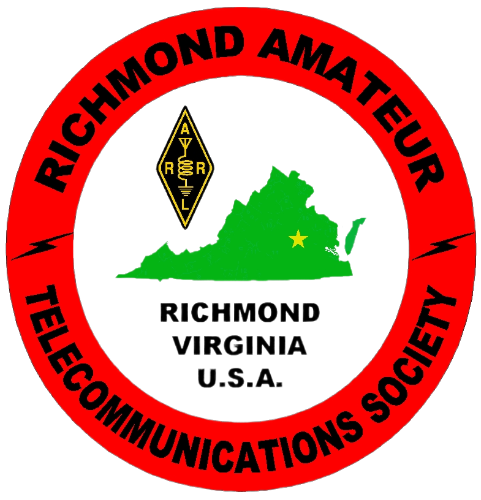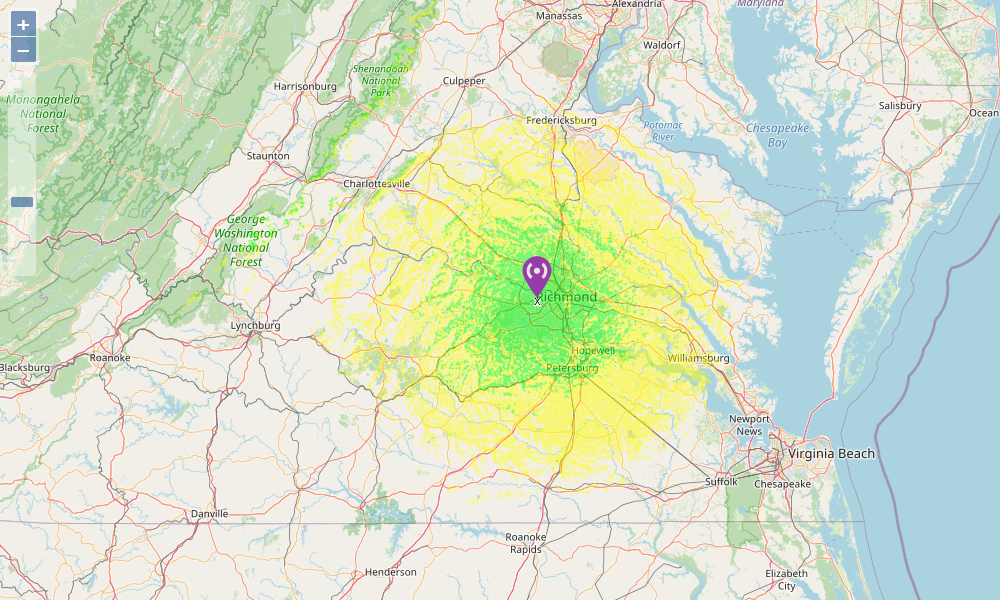|
W4RAT DMRVA C-Bridge Repeater
 RATS operates a Digital Mobile Radio (DMR/MotoTRBO™) repeater as part of the DMRVA system which covers most of Virginia. This repeater went into service on May 30, 2014 with the generous assistance of Jay Lovelady KD4BPZ and Dave Meier N4MW. This Motorola XPR8300 was originally placed in service on a backup UHF antenna at around 465 feet. It spent 2020-2022 at 680 feet. It's currently using an antenna at 580 feet. And it'll move again, back to 465 feet, if/when we reinstall a backup VHF antenna at that 580 foot position. Transmitter power was given a boost from 20 to 25 watts (full power) in July 2023 when this repeater was reinstalled following a nearly one-year hiatus.
RATS operates a Digital Mobile Radio (DMR/MotoTRBO™) repeater as part of the DMRVA system which covers most of Virginia. This repeater went into service on May 30, 2014 with the generous assistance of Jay Lovelady KD4BPZ and Dave Meier N4MW. This Motorola XPR8300 was originally placed in service on a backup UHF antenna at around 465 feet. It spent 2020-2022 at 680 feet. It's currently using an antenna at 580 feet. And it'll move again, back to 465 feet, if/when we reinstall a backup VHF antenna at that 580 foot position. Transmitter power was given a boost from 20 to 25 watts (full power) in July 2023 when this repeater was reinstalled following a nearly one-year hiatus.
Like the rest of the W4RAT repeater systems, the DMR repeater and its network connectivity are serviced by emergency battery and diesel generator power.
Planning to use a DMR hotspot? Read this first.
Questions about the DMRVA network, including requests relating to nets or special events on a DMRVA member repeater, should be directed to DMRVA. Questions about the RATS DMR repeater specifically may be directed to our Technical Committee.
Basic Configuration
Frequency: 443.5875 MHz, +5 MHz offset
Call Sign: W4RAT/R
Mode: DMR Tier II, fully digital (two time slots)
Configuration: Color Code 1
C-Bridge talk groups are configured by the repeater owner and can be designated as either dynamic (PTT-activated) or static (always on). A list of current DMRVA talk groups is available here.
Network Status and Traffic, Audio Streams
You can listen to select talk groups online and see recent traffic using Last Heard.
Network status for the DMRVA portion of the network can be viewed on Peer Watch. This page explains how to read Peer Watch.
Messaging and APRS
Messaging - Motorola radios: Text Message Type DMR Standard, Compressed UDP Header Type None, use any talkgroup on time slot 1
Messaging - Non-Motorola radios: Use format Standard or Motorola, use any talkgroup on time slot 1
APRS Position Beacons: Disable
Note that there are significant variances in support for text messaging among radio makes and models. Users should conform to the recommended settings provided above to ensure maximum compatibility between radios.
Text messages are a local operation confined to our repeater. Messages will not be forwarded to radios on other repeaters, except PBG/Petersburg.
Remember, DMR text messaging is not a store-and-forward system. If the user's radio is not tuned in to our repeater (or PBG) on time slot 1 when the message is sent, they will not receive it.
APRS position beacons must be disabled on all DMRVA repeaters.
Experimental DMR IP Data
DMR IP Data: Time slot 1, CAI Network 12, CAI Group Network 255, Data Call Confirmed Off
Limited use of DMR low-speed IP data functions may be permitted on our repeater, but only with the advance permission of the repeater trustee. Please limit data activity while voice conversations are in progress on time slot 1. Data capabilities currently require Motorola equipment.
Data operations are only permitted on the W4RAT repeater at this time. Data sessions are confined to our repeater and will not propagate to other networked repeaters.
For better performance, we recommend lowering your radio's guard signal via the CPS if it is used only for data traffic. 80 to 100 milliseconds has worked well in testing and can significantly reduce data network latency.
Here's our handy DMR IP address lookup tool:
To calculate the DMR IP address of a radio, enter the DMR ID and CAI Network. Default is 12.
To calculate the DMR IP address of a talkgroup, enter the talkgroup ID and CAI Group Network. Default is 255.
DMRVA & HEARS Repeaters - Talkgroup List
As of January 1, 2024. Click here for coverage estimations.

Notes:
- CC = color code. Either 1 or 9 is used on repeater sites.
- UHF repeaters frequency offset is + 5Mhz. Listed frequency is repeater transmit. Enter this frequency as your mobile/portable receive frequency.
- Frequency offset is - 600 kHz for Fredericksburg VHF. Listed frequency is repeater transmit. Enter this frequency as your mobile/portable receive frequency.
- Frequency offset is + 600 kHz for Fort Lewis VHF. Listed frequency is repeater transmit. Enter this frequency as your mobile/portable receive frequency.
- "On" means the talkgroup is always connected. There is no need to "kerchunk" to activate this talkgroup. Where a number is shown -- either 5 or 15 -- this is the inactivity timeout for on-demand talkgroups. Try to remember to use the Clear Timeslot function when you are done using any of these channels.
- Colors for 27500 indicate local TG's that are connected together. Gray is local only. 27500 may have name variations (i.e. Richmond Metro, Rapp Regional, etc).
- Richmond Metro is also available through the Brandmeister network on 31511 and PTT on Spotsylvania repeaters TS1 TG 31511.
- Roanoke Local is also linked to Brandmeister Long Ridge site (BM TG 315136).
- Echotest is available on TG 9998 and 9999 (group call). Both enabled to make transition from N4HRS to DMRVA easy for users.
- Testing/Intermittent availability, pending final site work in early 2024.
An Important Note about Codeplugs
As of August 2022, DMRVA no longer furnishes pre-built codeplugs for its network but we have some available. For additional information, see this page.
DMRVA Repeater List and Site/Zone IDs
For additional information see the RATS Codeplug Project.
DMRVA+HEARS Combined System Map
Static Talk Groups
Our two static talk groups are Richmond Metro and Virginia Statewide. These two talk groups are always active.
Dynamic Talk Groups
All
other talk groups are dynamic: they're only active when needed. Most
of the time you will not hear any traffic on these talk groups. While
the repeater will allow more than one simultaneous dynamic talk group to
be active, this will produce unpredictable and usually undesirable
behavior. Here are some best practices for using dynamic talk groups:
Best practice: Have a channel configured in your radio to perform a
"monitor all" or "scan" function on all talk groups to ensure nobody
else is currently using a dynamic talk group. You'll need to set this
up in advance using your radio's CPS. Listen for a reasonable amount of
time (10-15 seconds).
Select the desired talk group, briefly press the PTT key. Yes, kerchunk
the repeater. (We know, you've been trained for years that this is
bad, but it's better than barging in on top of someone's QSO with your
call sign. Here's the official word from DMRVA.)
This kerchunk will activate the talk group. Because talk groups are
shared with other repeaters on the network, you will again need to wait
several moments to begin hearing any distant traffic that may already be
taking place on that talk group.
Hearing no traffic on that talk group, make your call. It's a good idea
to say which talk group you're calling on because the receiving station
may have their radio in a scan mode. "AB1CDE, this is K4ABC on
Virginia Southwest"
When you are finished with your QSO, transmit your call sign to the
"Clear Time slot" talk group. This will deactivate the dynamic talk
group and free the repeater for another user.
Dynamic talk groups are on a timeout and will deactivate if there is no
local traffic (that is, no transmissions coming in to our repeater) for
15 minutes (5 minutes on TAC A and TAC B). You will need to transmit to
the talk group to reactivate it after timeout. If you have a special
need for extended access to a dynamic talk group, consider the use of a
DMR hotspot device instead of the repeater.
Locals and Metros
The Local talk group (27500) works a little different depending on which DMRVA or HEARS repeater you are using.
In many instances, the Local talk group is shared across multiple repeaters. When more than one repeater share a Local talk group, we call this a Metro talk group. When you transmit into Metro, you are coming out of multiple repeaters in your area. The talkgroup number is unchanged across all repeaters - 27500.Receiving a Call on a Dynamic Talk Group
If you are expecting a call from someone on a different repeater (including another DMRVA repeater) using a dynamic talk group, you will need to already have the talk group active in order to hear their incoming call. Follow the procedure described previously for activating a dynamic talk group. Of course, if you're the one initiating the call, the distant party will need to have done the same, otherwise the talk group will not be active on their end.
Coverage Map
Above: Map showing projected coverage of the RATS 443.5875 MHz DMR repeater, generated using Radio Mobile Online by Roger Coudé VE2DBE.


